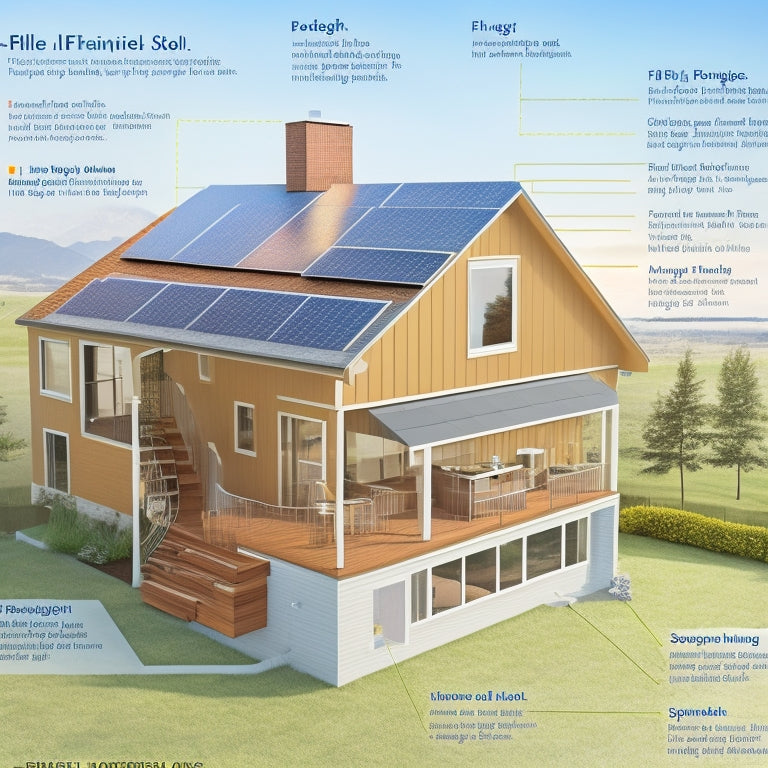
What Insulation Maximizes Solar Home Energy Efficiency?
Share
You can maximize your solar home's energy efficiency by incorporating a combination of high-performance insulation materials and strategic design elements that work in harmony to minimize heat gain and loss. Spray foam insulation, radiant barriers, and high R-value materials like insulated concrete forms and structural insulated panels are key players in this effort. By applying these materials thoughtfully in walls, ceilings, and floors, you'll reduce thermal bridging, air leakage, and heat transfer. As you investigate these solutions further, you'll uncover how to optimize your solar home's energy efficiency and release its full potential.
Key Takeaways
- Spray foam insulation offers high R-value and is ideal for attics, walls, and floors, maximizing energy efficiency in solar home design.
- Radiant barriers effectively reduce heat gain in summer and heat loss in winter, making them suitable for ceiling insulation.
- High R-value materials like insulated concrete forms and structural insulated panels are recommended for wall insulation in solar homes.
- Energy-efficient glass with low-e coatings and insulated frames minimizes heat loss and gain in windows, enhancing overall energy efficiency.
- Insulated outlet covers and air leak prevention through sealing techniques and materials like caulk, weatherstripping, and spray foam are crucial for optimal energy efficiency.
Insulation Types for Solar Homes
When it comes to building a solar home, your insulation strategy plays an essential role in maximizing energy efficiency.
You'll want to evaluate two types of insulation: spray foam and radiant barriers. Spray foam insulation provides a high R-value, which measures its ability to resist heat flow, making it ideal for attics, walls, and floors.
In addition, incorporating sustainable road trip amenities like solar canopies and rainwater systems can further enhance energy efficiency. By leveraging renewable energy sources, such as wind and solar power, you can reduce your reliance on traditional energy sources.
Energy Efficiency in Walls
By incorporating spray foam insulation into your solar home's design, you've taken a notable step towards maximizing energy efficiency.
Additionally, strategic design and layout of your solar panel system can also minimize material waste and labor hours, ultimately maximizing energy production Optimize System Design.
However, it's essential to evaluate the wall materials you're using to guarantee peak performance.
Thermal bridging, which occurs when heat escapes through gaps in the insulation, can greatly reduce energy efficiency.
To minimize thermal bridging, use wall materials with high R-values, such as insulated concrete forms or structural insulated panels.
Additionally, reflect on using continuous insulation, like foam board or fiberglass batts, to reduce heat loss.
Ceiling Insulation Strategies
Beyond the walls, your ceiling presents another essential opportunity to fine-tune your solar home's energy efficiency. You can maximize energy savings by implementing effective ceiling insulation strategies.
By integrating renewable energy sources, such as solar power for EV charging, into your overall energy plan, you can further reduce your carbon footprint and reliance on fossil fuels.
Consider installing radiant barriers in your attic to reflect heat rather than absorb it. This reduces heat gain during summer and heat loss during winter.
Additionally, incorporate thermal mass materials, such as concrete or brick, into your ceiling design to absorb and release heat as needed. Properly insulating your ceiling also helps to reduce air leakage, which can account for up to 30% of energy losses.
Floor Insulation Essentials
Your ceiling is now optimized for energy efficiency, and it's time to focus on the next vital area: your floors. Proper floor insulation is essential in maximizing solar home energy efficiency. It helps reduce heat loss in winter and heat gain in summer, ensuring a consistent indoor temperature.
Regular maintenance, including cleaning and inspecting connections, is fundamental for optimizing performance and ensuring longevity, as regular cleaning of solar panels can prevent up to 20% efficiency loss. Additionally, achieving energy independence mitigates volatility in fuel prices and enhances operational efficiency through solar energy utilization.
When selecting floor insulation materials, consider the following benefits:
-
Reduced energy consumption: Floor insulation materials like foam board, fiberglass batts, and radiant barrier insulation help minimize heat transfer, reducing your reliance on HVAC systems.
-
Increased comfort: By maintaining a consistent indoor temperature, you'll enjoy a more comfortable living space.
-
Moisture control: Floor insulation benefits also include preventing moisture accumulation, which can lead to mold growth and structural damage.
Window Insulation Solutions
You'll want to optimize your windows' energy efficiency by addressing two vital areas: the frame and the glass.
Window frame insulation is essential, as it can greatly reduce heat transfer and prevent air leaks. By selecting energy-efficient glass with low-e coatings and insulated frames, you can minimize heat loss and gain, maximizing your solar home's energy efficiency.
Additionally, renewable energy solutions like solar power can further enhance the energy efficiency of your home. Achieving energy independence can minimize reliance on the grid, improving brand reputation and attracting environmentally conscious customers.
Window Frame Insulation
As homeowners invest in solar panels to employ renewable energy, they often overlook a crucial aspect of energy efficiency: window frame insulation.
You might assume that the glass is the only component responsible for energy loss, but the frame materials play a significant role in thermal performance.
When selecting window frames, consider the following factors to optimize energy efficiency:
-
Material selection: Choose frames made from materials with low thermal conductivity, such as fiberglass, vinyl, or thermally broken aluminum.
-
Frame design: Opt for frames with a multi-chambered design, which reduces heat transfer and minimizes convection.
-
Sealing and weatherstripping: Verify proper sealing and weatherstripping to prevent air leaks and reduce heat loss.
Energy Efficient Glass
Maximizing thermal performance in windows requires attention to the glass itself, which can be a notable contributor to energy loss.
You'll want to select energy-efficient glass options that minimize heat transfer and optimize solar gain. Look for low-e coatings, which reduce heat loss in winter and heat gain in summer.
Additionally, consider insulated glass units (IGUs) with gas fillings like argon or krypton, which further reduce conduction.
These solar home innovations can markedly enhance energy efficiency benefits, reducing your reliance on heating and cooling systems.
Door Insulation Best Practices
About 10% of the heat in your home escapes through its doors, making door insulation a crucial aspect of maintaining energy efficiency.
To guarantee your doors are well-insulated, consider the following best practices:
-
Choose door materials with high insulation values, such as fiberglass or steel doors with foam core insulation.
-
Apply weather stripping around the door frame to prevent air leaks and seal gaps.
-
Install a door sweep or threshold seal to block cold air from entering and warm air from escaping at the bottom of the door.
Insulating Around Electrical Outlets
You'll want to focus on three key areas when insulating around electrical outlets: applying outlet box sealant to prevent air leaks, sealing gaps and cracks around the outlets, and installing insulated outlet covers.
These measures will help reduce heat loss and energy waste in your solar-powered home.
Outlet Box Sealant
Plug into energy savings by sealing the gaps around your electrical outlets.
Outlet insulation is essential to prevent energy loss, as even small gaps can let heat escape. To maximize energy efficiency, you'll want to guarantee that the outlet box sealant is properly installed.
Here are some key considerations for effective outlet insulation:
- Choose a sealant specifically designed for outlet boxes, as it will provide the necessary insulation and moisture protection.
- Apply the sealant according to the manufacturer's instructions, taking care to fill all gaps and voids.
- Verify that the sealant is compatible with your outlet type and meets local building codes and regulations.
Sealing Gaps and Cracks
During the construction or renovation of your home, sealing gaps and cracks around electrical outlets is an essential step in maximizing energy efficiency.
You'll want to guarantee that the areas around outlets are airtight to prevent heat from escaping or entering your home. To do this, use drafting techniques to identify and address any gaps or cracks.
Apply weatherproof materials, such as spray foam or caulk, to seal these openings. Pay particular attention to the areas where the outlet meets the wall and the electrical wires enter the outlet box.
Insulated Outlet Covers
Sealing gaps and cracks around electrical outlets is just the first step in maximizing energy efficiency. You're not done yet!
Insulated outlet covers are an essential addition to preventing energy loss. These covers are made from various outlet cover materials, such as foam, plastic, or fiberglass, designed to fit snugly over outlets and switches.
They help to:
- Block cold air from entering through the outlet openings
- Prevent warm air from escaping through the same openings
- Reduce air leakage around outlets, switches, and electrical devices
Sealing Air Leaks Effectively
About 30% of the heat gained in summer and lost in winter is due to air leaks, making them a significant obstacle to achieving ideal solar home energy efficiency. You'll want to prioritize air sealing techniques to minimize heat loss and gain. Thermal bridging, where heat escapes through gaps in the building envelope, is a common issue. To combat this, focus on sealing areas around windows, doors, electrical outlets, and switches.
| Area | Sealing Method | Material |
|---|---|---|
| Windows | Caulk or weatherstripping | Silicone or foam |
| Electrical outlets | Outlet sealers or spray foam | Foam gaskets or spray foam |
| Doors | Weatherstripping or door sweeps | Foam or vinyl |
| Switches | Switch sealers or spray foam | Foam gaskets or spray foam |
| Baseboards | Caulk or spray foam | Silicone or spray foam |
Frequently Asked Questions
Can I Use Insulation Materials With High Carbon Footprint for Solar Homes?
You can use insulation materials with high carbon footprint for solar homes, but it's essential to weigh the energy efficiency benefits against the eco-friendly alternatives and carbon footprint considerations, ensuring your sustainable goals aren't compromised.
How Do I Balance Insulation and Ventilation in My Solar Home?
You'll find that balancing insulation and ventilation is essential; research suggests that proper ventilation can reduce heat gain by up to 90%. You'll want to choose insulation types like fiberglass or cellulose, and implement ventilation strategies like whole-house fans or solar-powered vents.
Are There Insulation Materials That Can Also Serve as a Fire Barrier?
You'll find that fire-resistant insulation materials, like mineral wool or ceramic blankets, can effectively serve as a thermal barrier, providing a vital layer of protection against heat transfer and potential fires in your solar home.
Can I Reuse Insulation Materials From My Old Home in My New Solar Home?
You can't reuse insulation materials from your old home in your new solar home, as their performance may degrade over time; instead, choose high-quality insulation types like spray foam or fiberglass that guarantee peak energy efficiency.
Are There Local Building Codes for Insulation in Solar Homes I Should Follow?
You maneuver local building codes like a pro, ensuring your solar home meets regulations; scrutinize insulation standards, adhering to local regulations that dictate R-values, materials, and installation methods, guaranteeing freedom from energy waste and exorbitant bills.
Related Posts
-

10 Best WiFi Outlets for Tracking Home Energy Usage
You can optimize your home's energy usage with the right WiFi outlets, which provide real-time monitoring and control...
-

Why Merge Earth's Heat With Sun's Energy?
You're about to utilize the full potential of renewable energy by combining the Earth's natural heat with the Sun's a...
-

Why Transform Human Waste Into Garden Gold?
By changing human waste into garden gold, you'll reduce waste management costs, support sustainable agriculture, and ...


